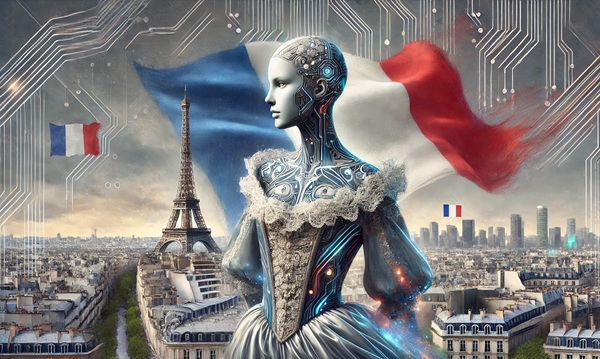Each week we find a new topic for our readers to learn about in our AI Education column.
Technology has its places—and by technology, we mean information-age technology, not industrial technology—and by places, we’re talking geography, and if there has been one stand-out place for information-age (and maybe post-information age) technology, it’s been the region stretching southward from the San Francisco Bay colloquially known as Silicon Valley. But now an artificial intelligence age has dawned, and while Silicon Valley is still a key participant, if not the biggest player, in the AI boom, it’s not as dominant as it was in previous decades.
Welcome to another edition of AI Education where we’re going to discuss Mistral AI, a French AI developer that has become the most highly valued and fastest-growing pure AI business outside of Silicon Valley.
Mistral, headquartered in Paris, is not alone. We would invite you to look through some of our weekly listings of the five biggest venture capital deals in AI, and you’ll find companies thriving in Stockholm, Sweden and London, U.K., as well as in North American locations around the northeastern urban and educational centers—Boston and Cambridge, Mass.; New York City, Princeton, N.J. and the Philadelphia area—as well as hotspots throughout locations in Texas, Florida, the mountain west and the midwest. AI is everywhere—and that’s how we got to talking about Mistral today, we wanted to cover a company outside of the usual narrow sliver of California that sees the most attention, and Mistral is one of the biggest and most fascinating.
Who Is Mistral AI—a Little Background
All of that introduction shouldn’t cover up the basic truth that Mistral AI was founded in April 2023 by three veterans of mega-cap technology companies already deeply involved in artificial intelligence. Mistral founder Arthur Mensch is a veteran of Google DeepMind (which we recently wrote about), while the other co-founders, Guillaume Lample and Timothée Lacroix, came over from Meta Platforms.
Mistral AI’s mission and business is similar to that of Open AI—it develops and releases open-source AI software that is generally free-to-use for the public, and as a source of revenue it allows developers, businesses and institutions to access and use advanced foundation models for a price. Mistral’s public face is that of an initiative to make AI accessible and transparent, but, along the way they are developing valuable and marketable technologies.
As of this writing, the company has raised over $1 billion, and it reportedly plans to raise another $1 billion in the near future. The most recently reported funding round, in December 2024, raised approximately $645 million at a $6.2 billion valuation, making it the fourth-most valuable AI company globally and the largest AI concern outside of California. Not only is Microsoft among Mistral’s investors, but via a partnership, Mistral’s models are available via Microsoft’s Azure Cloud.
So, a company that’s younger than our preschooler has already brought $1 billion into the door and is worth $6.2 billion. The little tyke has some catching up to do!
Still, as impressive as $6.2 billion sounds, remember that OpenAI’s valuation today sits around $80 billion.
What Mistral Has Done
Mistral 7B, Mixtral 8x7B,
Mistrals first models—and many since—were released freely. They are open source, meaning their code, data, and often their weights and parameters are at least visible to users, if not modifiable and customizable. Mistral’s offerings are touted as being adaptable to work with different settings and compliance schemes. These are language models. Mistrals models are multilingual, fully fluent in French, Spanish, Italian, German and English.
Mistrals models are claimed to outperform similar contemporary peers in most performance benchmarks—Mistral came out of the gate creating more efficient models, generating comparable results using fewer parameters (and thus less energy and time).
These models are primarily intended to be used for content creation, summarization, classification, code completion and chatbots. Speaking of chatbots…
Le Chat
OpenAI offers the entire world access to ChatGPT via a chatbot interface, similarly, Mistral offers access to many of its models via Le Chat, its AI chatbot that answers questions, searches the internet, generates content and does. Le Chat is available free on Mistral’s website and via a mobile app, but there is a paid enterprise version that organizations can customize to their needs, and Le Chat Pro, a paid tier for non-enterprise users.
Other Mistral Offerings
Mixtral
A new Mixtral was launched in April 2024 as the most advanced of Mistral’s open models. The Mixtral models use a mixture of experts architecture, meaning that while it has tens or hundreds of billions of parameters available to complete tasks, at any given time it’s only using a fraction of them—Mixtral splits parameters among smaller models called experts, that are only active when being used, reducing energy costs. Both Mistral models use eight experts (hence the 8x in their names), with the first version offering approximately seven billion parameters per expert, and the second 22 billion.
Magistral
Launched this spring, Magistral is Mistral’s reasoning model, released as a “small” open version and a “medium” proprietary version. It is claimed to have chain-of-thought capabilities
Pixtral and Mathstral
Built on Mistral 7B, Mathstral is a large language model with a STEM focus, capable of solving complex mathematical problems, while Pixtral is a tool that can convert images or drawings to text or code, or vice versa.
Ministral
Also called “Les Ministraux,” Mistral has developed a family of models for edge devices like mobile phones.
Codestral, Codestral Mamba, Devstral
The Codestral models are coding models that are fluent in 80 programming languages. They cannot be used for commercial purposes. These models are intended for developers, who use them to solve difficult coding problems. Devstral offers engineers an agentic software development tool and is available for commercial applications.
Mistral Commercial Models
Small, Medium, Large, Large 2, Embed: The first of these, Small, Medium and Large, were initially launched in 2023 and 2024, with recent newer versions launched since. Small, medium and large refer to efficiency and applications. Large 2 is currently Mistral’s flagship large language model, and, with 123 billion parameters, its largest model.







